Senior Capstone 2017
Our ESS Capstone course is a problem-based, project oriented course for seniors which allows them to apply their skills by helping an outside organization with an environmental issue facing a certain region. This year’s senior Capstone projects were led by professors Leslie Gray, Jonathan LaRiviere, and Stephanie Hughes. Leslie’s class worked on projects related to urban agriculture and food security in the Santa Clara County region for the local Food System Alliance. Jonathan’s groups tackled projects related to the intersection of marine science, spatial data, and conservation. Stephanie’s cohort took on cases where the issue of local water quality intersected with consumer product use and subsequent waste. The students worked throughout winter quarter to characterize the problems, analyze possible solutions, and present the results at a public forum. The goal of this capstone was to relate theoretical knowledge and skills to applied problems, with students working collaboratively in real world situations to research and communicate.
Here’s the scoop on each of the capstone groups by class:
Leslie Gray's section:
Urban and Peri-Urban Agriculture: A Geospatial Exploration of Santa Clara County
[Vanessa Caustrita, Lauren Jeakins, Matthew Kozal, Hector Maldonado]
This group used Geographic Information Systems (GIS) to examine the history of farm loss in SCC, map small farms, and identify potential new sites for urban agriculture. They concluded that peri-urban agriculture in the southern part of the county is most at risk of development. They also determined the best locations for potential Urban Agriculture Incentive Zones (UAIZs) to increase accessibility for people of the lowest income.
Innovations for Viable Urban Food Systems
[Hailey Kennedy, Beatriz Lemus, Claire Smoker and Andrew Wang]
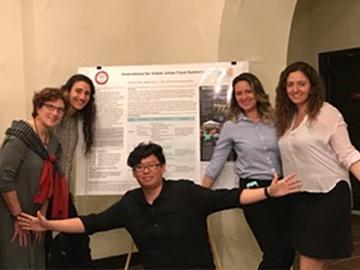
These students explored the characteristics of a viable food system through case studies to determine which innovative food systems models could be most readily implemented in Santa Clara County. They identified hotspots such as Seattle, Detroit, and Oakland where food accessibility is increasing through community outreach, collaboration among stakeholders and diversifying markets.
Barriers to Urban and Peri-urban Agriculture in Santa Clara County
[Elia Kazemi, Kaitlyn Kuehn, Margee McDonnell, Sammie Yamashita]
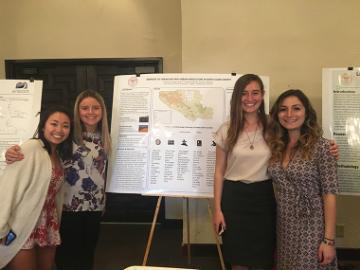
This group interviewed local urban and peri-urban farmers to find out what the greatest barriers to viability as well as their unique needs and recommendations for policy. The biggest barrier turned out to be land access, compliance issues, changing environmental conditions, and policy and labor restrictions. Going forward, they would like to see these issues addressed through increased education, a toolkit of resources for local agriculture in SCC, and improved community engagement.
Labor Land and Food: Policy Barriers to Urban Agriculture in Santa Clara County
[Miranda Conlon, Laura Schumacher, Lindsay Tenes, Deja Thomas]
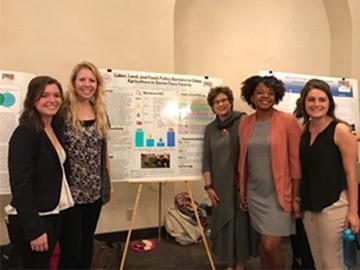
This team explored how policies in Santa Clara County create barriers for urban farmers, as well as how policies in other cities may promote urban farming. They then determined which of these policies could be implemented in SCC. Their recommendations included tax breaks for land use which provide ecosystem services and more exposure of agricultural careers to young people. They also recommended more efficient water management and the creation of local food hubs and to incentivize farmers markets through easier permitting processes.
Jonathan LaRiviere’s section:
Assessing Marine Debris in the United States: A GIS analysis of NOAA’s MDMAP Citizen Science Data
[Hannah Dennis, Kristofer Hausmann, Jack Seiver, Erica Stanislawski]
The goal of this group was to create a GIS representation of Marine Debris Monitoring and Assessment Program (MDMAP) dataset and produce a story map for NOAA. Their goals were to identify regional and seasonal trends in marine debris magnitude and composition, determine if temporal events, such as storms and holidays, have an impact on coastal marine debris, and understand how effective local conservation policies, such as plastic bag bans, have been at reducing trash on beaches.
Colonial Waterbird Analysis in the San Francisco Bay Area (1980-2016)
[Alison Ganci, Taylor Gustafson, Brynn Littlehale, John Spanos, and Devin Gomez]
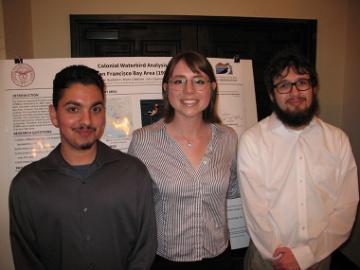
This team began by organizing several thousand observations from the Colonial Waterbird Program at San Francisco Bay Bird Observatory (SFBBO) into workable spreadsheets for GIS and SPSS analysis, then creating a geodatabase with both raw and analysis data and finally, analyzing datasets for significant nest size and nesting date trends in bird colonies and species. They then created a Storymap for the SFBBO website and gave SFBBO final spreadsheets and instructions on how to continue to add data and conduct analyses.
Turning The Tides: Coastal Stewardship For All
[Lillian Farnkopf, Sam Kennard, Eliana Marks, Brendan Phinny, Michael Whalen]
This group worked with Save The Waves Coalition (STWC) to conduct user-tests for the nonprofit organizations’ mobile app in order to determine how it can accommodate current and future efforts towards marine conservation. They concluded that the organization should add an interactive tutorial to improve data quality, allow app users to engage with other citizen science projects to maintain engagement and collaborate, include educational components for all ages to increase engagement, provide a feedback loop for contributors and projects they care about, and increase language options to provide platform for international growth.
Breeding Birds of Santa Clara County, 1987-2016
[Gabriella Carne, Ana Prussia, Aaron Asai, Cyril Kanda]
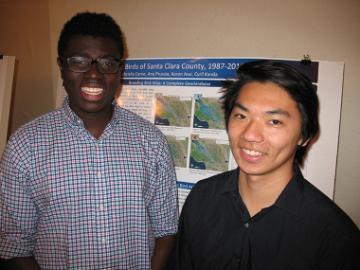
The research of this group was focused on utilizing the Santa Clara Valley Breeding Bird Atlas data in combination with recent eBird data in order to create a usable database for land managers. They also analyzed bird population trends overtime and raised awareness about endangered species in the local area. They concluded with the following recommendations: Require educational training for all citizen scientists on bird identification to increase accuracy, ensure equal distribution in study area of data collection in order to limit geographic bias, continue an ongoing electronic version of the data so that it can easily be transferred and analyzed in geographic information system programs, and publish the data using a public forum to ensure complete accessibility.
Stephanie Hughes’ section:
What Factors Prevent the Use of Refillable, 1 Pound Propane Cylinders in Santa Clara County?
[Ryan Hubert, Alex Piñon, John Pereira, George Giannos]
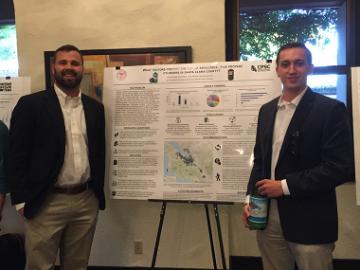
The environmental and personal cost of disposable 1 pound propane cylinders is high and the use is inefficient. This group sought to explore the major barriers preventing consumers from choosing reusable cylinders and provided recommendations to promote their use. After administering surveys and conducting research, their recommendations included the following: implementation of a propane cylinder exchange program, an initiative whereby the cost of disposable propane cylinders are subject to an additional, upfront cost, and a statewide effort by the California Product Stewardship Council to contact schools, especially colleges, with outdoor recreation programs for students in order to establish a legacy of environmentally conscious action.
Analyzing Current Flea Control Methods
[Jaro Bellier, Michael Lam, Lauren Moore]
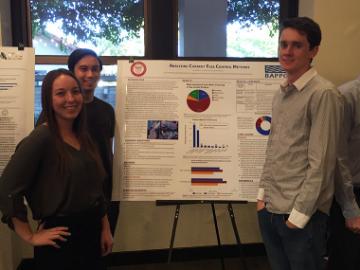
The aim of this study was to investigate current flea control practices in the Bay Area and determine what barriers are keeping people from transitioning to the use of safer and more environmentally-friendly flea control methods once restrictions are applied. In addition, they researched information regarding less harmful alternative flea control methods. They conducted a literature review and surveyed vets and pet owners to answer their research questions and create recommendations. These recommendations included: raising awareness about the dangers of spot-treatments, targeting outreach to veterinarians since they are the primary source of flea control information for the majority of pet owners, and offering easily accessible information to inform pet owners about less harmful alternatives.
Downtown Streets Team: Creek and Community Connections
[Allison Carmody, Casey McCormack, Erika Francks and Michael DeBroeck]
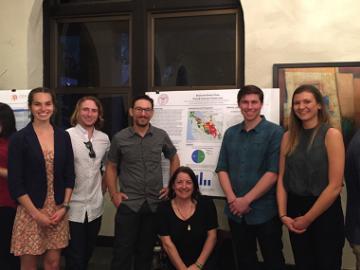
This project focused on Downtown Streets Team’s efforts to contribute to the 2022 100% trash reduction standard. They also looked into its’ value to the city of San Jose, and how other cities can adopt the DST model to reach the trash reduction goal set out in the The Municipal Regional Stormwater Permit (MRP). Through data analysis, interviews, field observations, surveys and GIS work, this group reached the conclusion that DST has contributed immensely to trash reduction in San Jose, eliminating more trash from waterways than all other non-city organizations combined in FY 2015-2016, demonstrating that their model has been effective.
Unleaded aviation fuel: Barriers to Adoption in California
[Saralena Barry, Ethan Hayden, Michelle Lam]
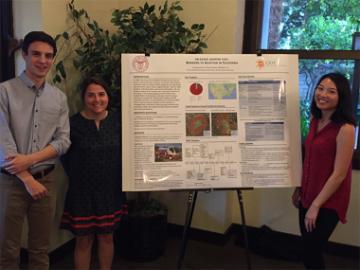
This group conducted interviews, a literature review, and case studies to determine the barriers to adoption of unleaded aviation fuel (avgas). Qualitative analysis revealed many barriers. However, the FAA and industry stakeholders are working to find a suitable alternative to leaded aviation fuel. The major benefits of unleaded avgas include: improved environmental and public health especially among children living or attending school near airports. They found that the biggest drawback of adopting unleaded avgas is the difficulty of implementation, which requires an increase in distribution infrastructure, consumer awareness and demand, and public-private collaboration.